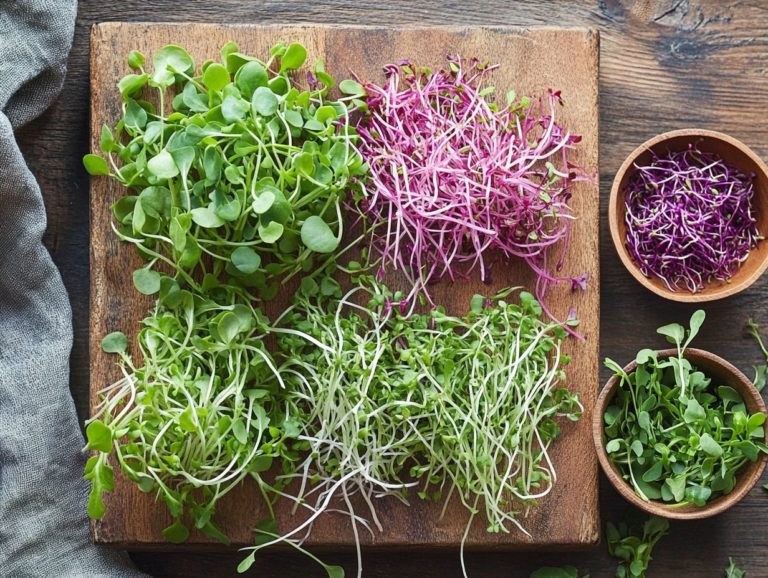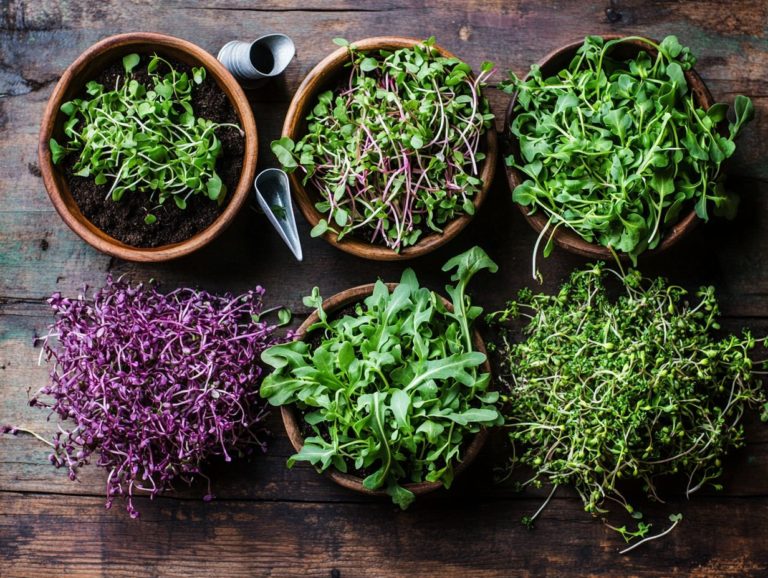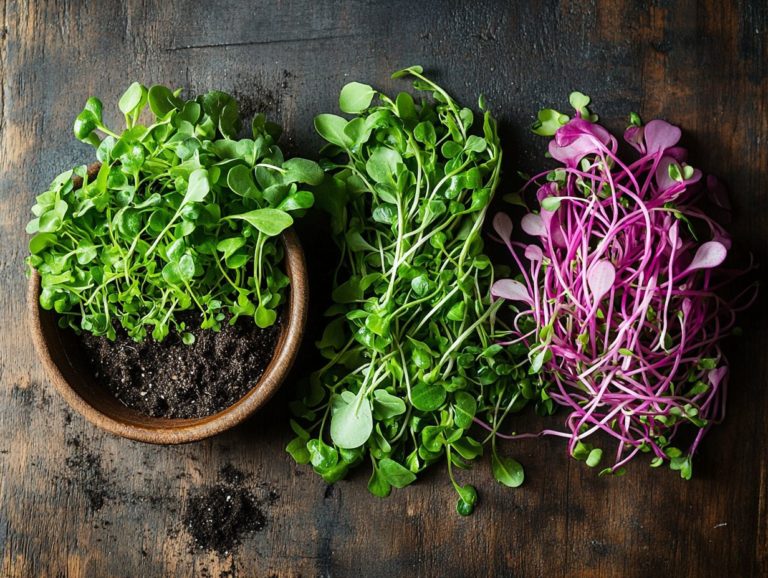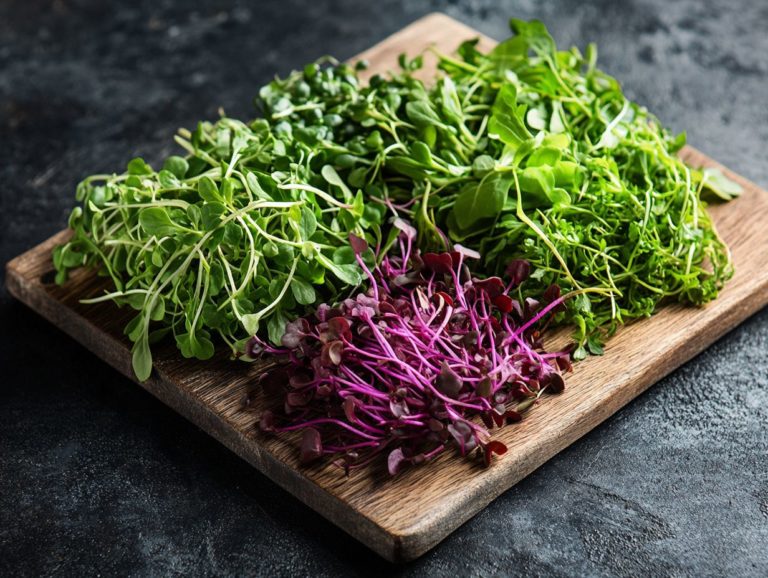Microgreens and Their Influence on Dietary Health
Microgreens are small, nutrient-dense plants that have taken the culinary scene by storm. These vibrant greens not only elevate the visual allure of your dishes but also deliver impressive nutritional benefits.
In this article, you ll discover what microgreens are, their remarkable health advantages, and how to cultivate them right in your home.
It also provides innovative ideas for incorporating these greens into your meals, along with essential precautions to keep in mind. Prepare to unlock the full potential of microgreens for a healthier diet!
Contents
- Key Takeaways:
- What are Microgreens?
- Benefits of Incorporating Microgreens in Diet
- How to Grow Microgreens at Home
- Ways to Include Microgreens in Meals
- Potential Risks and Precautions
- Frequently Asked Questions
- What are microgreens and how do they contribute to dietary health?
- What specific health benefits do microgreens offer?
- Are all microgreens equally beneficial for dietary health?
- How do microgreens compare to their mature counterparts in terms of nutrition?
- Can microgreens be grown at home for a convenient and cost-effective way to incorporate them into a healthy diet?
- How can microgreens be incorporated into daily meals for maximum health benefits?
Key Takeaways:

- Microgreens are nutrient-rich young plants that offer a variety of health benefits when included in the diet.
- Including microgreens in meals can lead to increased nutrient intake and a reduced risk of chronic diseases.
- Growing microgreens at home is simple and can add a burst of flavor and nutrition to any meal.
What are Microgreens?
Microgreens are young vegetables that you can harvest at a remarkably early stage, usually within 7 to 21 days after germination.
These petite greens bring a vibrant spectrum of flavors and colors to your meals, making them a delightful addition to salads, sandwiches, and gourmet dishes alike.
Microgreens are rich in essential nutrients and antioxidants. They not only delight your taste buds but also support a healthy diet.
Definition and Nutritional Value
Microgreens are your go-to choice for immature plants, harvested just as the first true leaves make their appearance. They come packed with a high nutritional value.
These tiny powerhouses are brimming with an impressive array of vitamins and minerals, especially vitamins K, A, and C. Take Swiss chard microgreens, for example; they not only provide a rich source of fiber (the part of plant foods that helps digestion) but also pack in antioxidants that support your overall health. To learn more about their benefits, check out the health benefits of microgreens explained. Similarly, red cabbage microgreens are celebrated for their contributions to gut health, promoting digestion thanks to their dietary fiber content.
Adding these microgreens to your meals can truly transform your diet! They play a vital role in reducing the risk of chronic diseases, enhancing your immune function, and contributing to a well-balanced diet. Understanding the role of microgreen varieties in plant-based diets can further elevate your nutritional intake.
Benefits of Incorporating Microgreens in Diet
Incorporating microgreens into your diet presents a remarkable array of health benefits. They enhance your nutrient intake and play a significant role in reducing the risk of chronic diseases like obesity, diabetes, and cancer.
Improved Nutrient Intake
One significant advantage of adding microgreens to your meals is the remarkable boost in nutrient intake. These tiny greens are packed with essential vitamins and minerals.
These nutritional powerhouses deliver a concentrated dose of goodness, making them an excellent choice for anyone eager to elevate their diet. For instance, broccoli microgreens and kale microgreens are particularly renowned for their impressive levels of vitamins K and C, which are vital for supporting your immune system and aiding in blood clotting. Additionally, exploring the top microgreen varieties for health enthusiasts can further enhance your nutrient intake.
The substantial iron content in microgreens like beet greens can help you maintain healthy energy levels and overall vitality. By seamlessly incorporating these nutrient-dense options into your daily salads or smoothies, you can effortlessly meet your dietary needs while enhancing your overall health.
Start growing your own microgreens today for a burst of flavor and nutrition in every bite!
Reduced Risk of Chronic Diseases
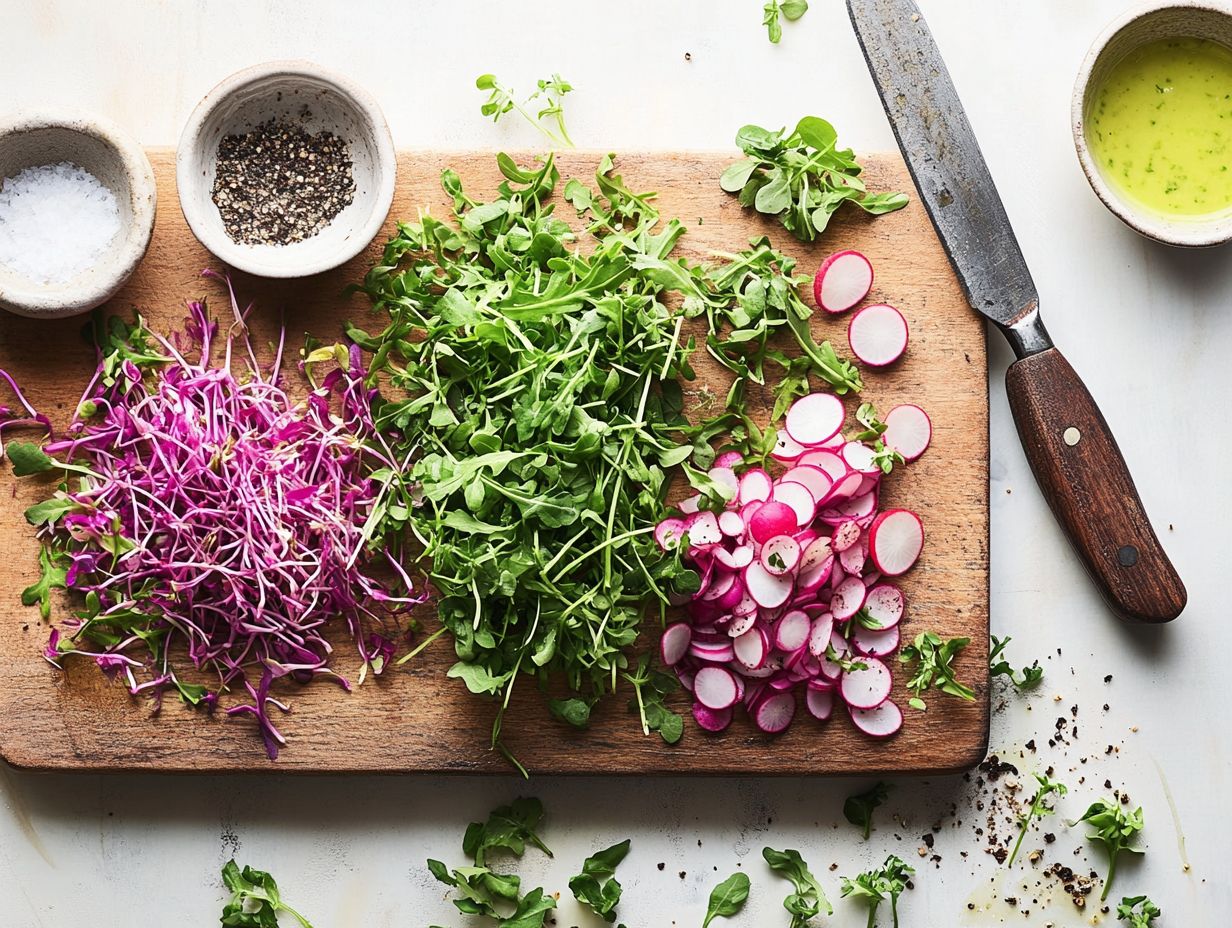
Microgreens play a vital role in reducing the risk of chronic diseases. They are packed with antioxidants and beneficial compounds like sulforaphane, a compound found in vegetables that may help fight cancer.
Two standout options are broccoli and red cabbage microgreens. These little nutrient powerhouses can significantly lower bad cholesterol, which is essential for maintaining heart health.
They also have a high fiber content that supports gut health. A thriving microbiome enhances digestion and nutrient absorption.
Studies from reputable health organizations, such as the Cleveland Clinic, show the cancer-fighting properties of sulforaphane, particularly prevalent in broccoli microgreens.
Incorporating these nutrient-dense greens into your diet elevates your meals. It s a proactive approach to safeguarding against various health concerns.
How to Grow Microgreens at Home
Growing microgreens at home is a rewarding and straightforward experience. You can savor these nutrient-rich and flavorful greens right from your kitchen.
Step-by-Step Guide
To successfully grow microgreens at home, follow this straightforward step-by-step guide. It covers everything from planting to harvesting.
Start by selecting seeds that match your taste preferences, such as radish, broccoli, or sunflower. After making your choice, prepare a suitable growing medium that s lightweight and nutrient-packed.
Sow the seeds generously across the soil surface. Ensure they have enough room to flourish without overcrowding.
Water gently but consistently. Keep the soil moist without drowning it, as excess water can lead to mold issues.
When your microgreens reach about 1 to 3 inches, harvest them easily with scissors. This adds a fresh and nutritious touch to your meals.
By following these practical tips, you can enjoy the rewarding experience of home gardening and reap its many benefits.
Ways to Include Microgreens in Meals
Microgreens effortlessly elevate a range of dishes. They infuse meals with vibrant flavors and exceptional nutritional benefits.
Creative and Delicious Recipes
Explore a collection of creative recipes that incorporate microgreens. These vibrant greens enhance the taste of your dishes while delivering a formidable nutritional punch.
Add them to refreshing salads that shine with citrus dressings. You can also blend them into smoothies for an extra nutrient boost alongside fruits and yogurt.
A sprinkle of microgreens can elevate gourmet creations like seared scallops or roasted vegetables. Transform an ordinary meal into an exceptional culinary experience!
Each recipe reveals countless ways to prepare and present these greens. They are packed with vitamins, minerals, and antioxidants that contribute to your overall well-being.
Potential Risks and Precautions
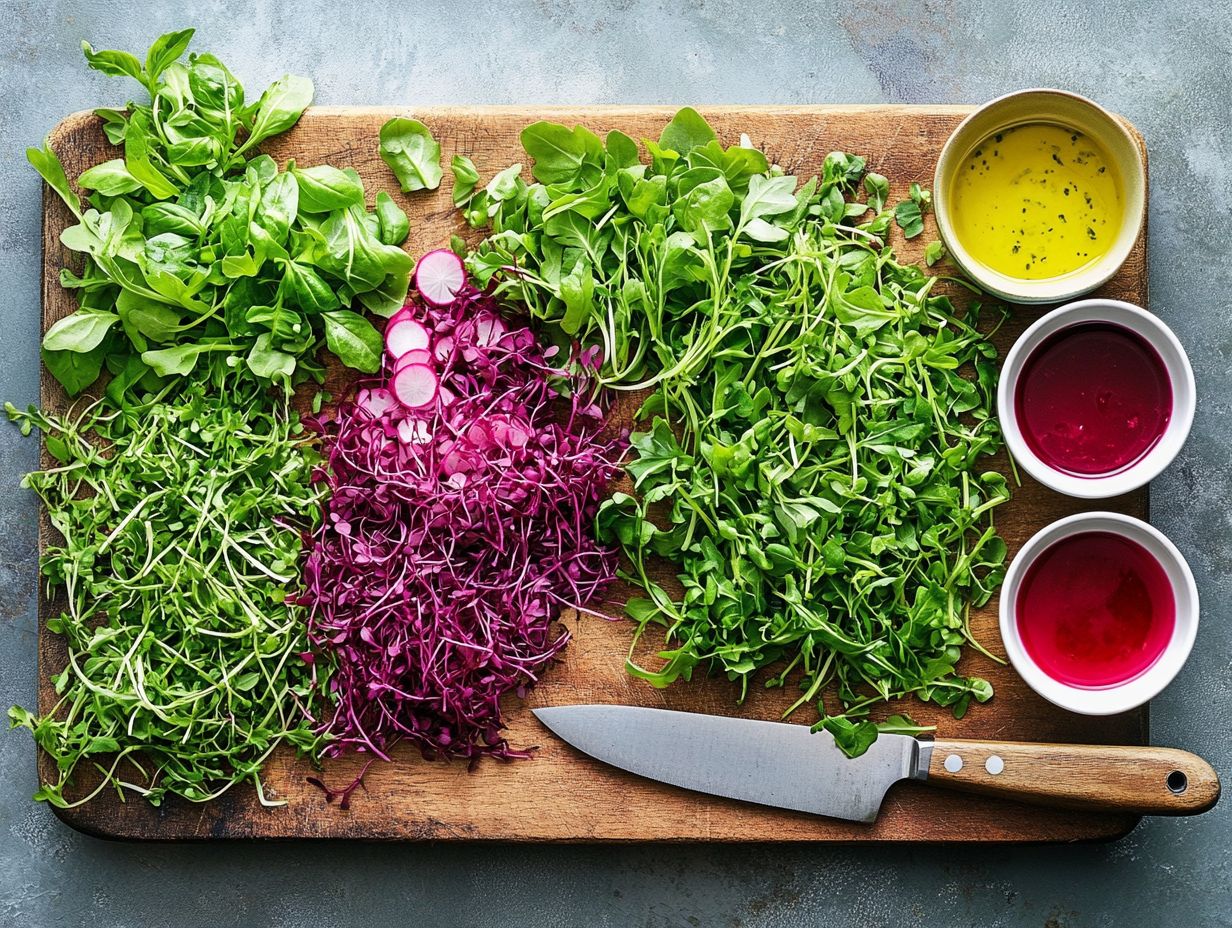
While microgreens provide many health benefits, you must recognize potential risks. Take necessary precautions to ensure their safe consumption.
Contamination and Allergies
Contamination is a pressing concern when it comes to growing and consuming microgreens, as wrong handling can cause food-related sickness. Various factors can heighten this risk, including soil quality, water sources, and even the seeds you choose.
If the environments where microgreens are grown aren t kept pristine, they can become breeding grounds for germs like E. coli and Salmonella.
Practicing good hygiene is essential always wash your hands meticulously, sanitize surfaces, and ensure that all equipment is spotless before use. Be mindful of potential allergies linked to certain microgreens, as they may provoke reactions in sensitive individuals.
To mitigate these risks, consider the following:
- Verify the source of your seeds and soil!
- Introduce microgreens into your diet gradually!
- Consult an allergist if needed!
Summary of Benefits and Tips for Incorporating Microgreens in Diet
Microgreens offer important nutrients and can seamlessly elevate your diet for enhanced nutrition. These petite greens, often brimming with a concentrated blend of vitamins and minerals, not only delight the eye but also amplify the flavors of your dishes.
They are full of antioxidants, which help digestion and reduce inflammation, making them a valuable addition to any meal. To get the most out of these nutritious plants, consider tossing a handful into your salads, sandwiches, or smoothies for a vibrant burst of flavor and nutrients! You might even sprinkle them atop soups or omelets for that extra touch.
Venturing into the world of microgreen varieties from the zesty kick of arugula to the sweetness of basil can turn your culinary experience into a delightful adventure. Adding microgreens to your meals can supercharge your nutrition!
Frequently Asked Questions
What are microgreens and how do they contribute to dietary health?
Microgreens are young vegetables that are harvested after the first leaves have sprouted. They are packed with nutrients and have a positive influence on dietary health, providing a nutritional boost. They can be added to salads, smoothies, sandwiches, and more.
What specific health benefits do microgreens offer?
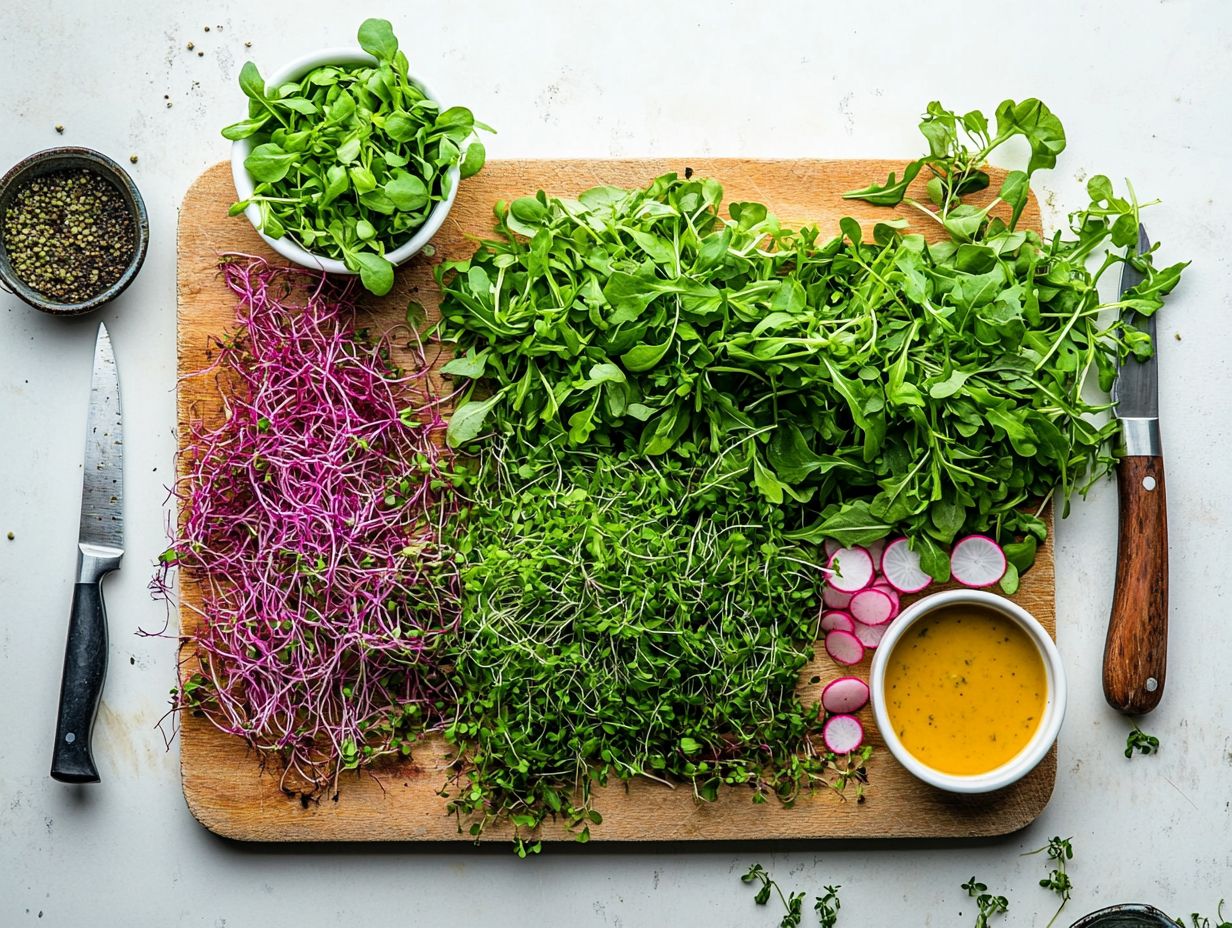
Microgreens are rich in vitamins, minerals, and antioxidants. They also contain natural compounds that help reduce inflammation and can lower the risk of chronic diseases such as heart disease, cancer, and obesity. They are low in calories and high in fiber, making them a smart choice for a healthy diet.
Are all microgreens equally beneficial for dietary health?
No, the specific health benefits of microgreens can vary depending on the type of greens. Some of the most nutrient-dense microgreens include broccoli, Swiss chard, arugula, and radish. However, all microgreens offer some level of nutritional value and can contribute to overall dietary health.
How do microgreens compare to their mature counterparts in terms of nutrition?
Studies have shown that microgreens can contain up to 40 times more nutrients than their mature counterparts. This is because the young plants are harvested at their peak of nutrient density. Microgreens are easier to digest, making their nutrient-rich components more readily available for the body to absorb.
Can microgreens be grown at home for a convenient and cost-effective way to incorporate them into a healthy diet?
Yes, microgreens can easily be grown at home using seeds and a few simple supplies. This allows for a fresh, convenient, and cost-effective way to add them to your daily meals, promoting gut health and ensuring that they are free from pesticides and other harmful chemicals.
Ready to boost your meals? Start growing your own microgreens today!
How can microgreens be incorporated into daily meals for maximum health benefits?
Microgreens are young plants packed with nutrients. You can easily add them to salads, soups, sandwiches, wraps, and smoothies.
Use them as a vibrant garnish on dishes like pizza or avocado toast. Be creative and try new ways to include microgreens in your meals for a powerful nutrition boost!

